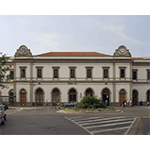Pistoia Railway Station
Built on a project by architect Angelo Gamberai from Pistoia, the Pistoia Station was one of the Grand Duchy’s most important railway junctions. It originally consisted of various halls and offices, a shed for locomotives and an area reserved to freight. Its reconstruction was decided in 1887, and completed two years later.
Three railways converged in Pistoia: the Maria Antonia that started from the homonymous station in Florence, the Lucchese that started from the Lucca Station, and the Porrettana that crossed the Apennines. The Lucca-Pistoia railway, which in Pistoia joined with the tract coming from Florence, and in Lucca with the one coming from Pisa, was built in several stages. In 1844, Duke of Lucca Carlo Lodovico di Borbone authorised the construction of the line from Lucca to the border with the Grand Duchy and, two years later, Leopold II did the same for the tract in the Grand Duchy. The line from Montecatini to Lucca was opened in 1853. Crossing the hill of Serravalle between Pistoia and Montecatini caused many problems, which were solved with the construction of a tunnel designed by engineer Tommaso Cini and opened in February 1859. The Porrettana line was completed in 1864. With its bridges and numerous tunnels, it represented a daring feat of engineering for the times, and still in service today offers the flavour of long ago.
****************************
Texts by Graziano Magrini
English translation by Victor Beard
Last update 09/feb/2008




